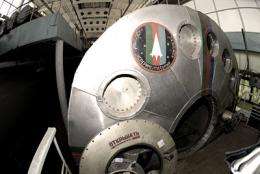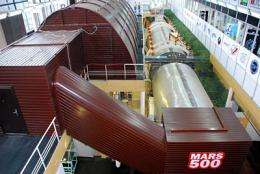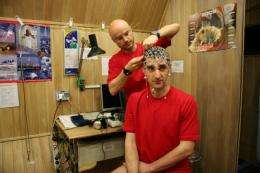The simulations will take place here on Earth inside a special facility in Moscow. A precursor 105-day study is scheduled to early 2009, possibly followed by another 105-day study, before the full 520-day study begins late 2009. Credits: ESA - S. Corvaja
(PhysOrg.com) -- Starting in 2010, an international crew of six will simulate a 520-day round-trip to Mars, including a 30-day stay on the martian surface. In reality, they will live and work in a sealed facility in Moscow, Russia, to investigate the psychological and medical aspects of a long-duration space mission. ESA is looking for European volunteers to take part.
Starting in 2010, an international crew of six will simulate a 520-day round-trip to Mars, including a 30-day stay on the martian surface. In reality, they will live and work in a sealed facility in Moscow, Russia, to investigate the psychological and medical aspects of a long-duration space mission. ESA is looking for European volunteers to take part.
The ‘mission’ is part of the Mars500 programme being conducted by ESA and Russia’s Institute of Biomedical Problems (IBMP) to study human psychological, medical and physical capabilities and limitations in space through fundamental and operational research. ESA’s Directorate of Human Spaceflight is undertaking Mars500 as part of its European Programme for Life and Physical Sciences (ELIPS) to prepare for future human missions to the Moon and Mars.
The Mars500 study takes place in a special isolation facility at the Russian Institute of Biomedical Problems in Moscow. The purpose of the Mars500 study is to gather data, knowledge and experience to help prepare for a real mission to Mars one day. The participants are subjects in scientific investigations to assess the effect that isolation has on various psychological and physiological aspects, such as stress, hormone regulation and immunity, sleep quality, mood and the effectiveness of dietary supplements. Credits: ESA
Following on from the successful 105-day precursor study completed in July, ESA is now looking for two candidates and two backups for the full 520-day study, which is due to get underway before mid-2010 after four months of training.
The crew will follow a programme designed to simulate a 250-day journey to Mars, a 30-day surface exploration phase and 240 days travelling back to Earth. For the ‘surface exploration’, half of the crew will move to the facility’s martian simulation module and the hatch to the rest of the facility will be closed.
Candidates should be aged 20-50, motivated, in good health and no taller than 185 cm. They should speak one of the working languages: English and Russian. Candidates must have a background and work experience in medicine, biology, life support systems engineering, computer engineering, electronic engineering or mechanical engineering.
Cyrille Fournier helps Oliver Knickel prepare for a nighttime EEG. Credits: ESA
Selection will be based on education, professional experience, medical fitness and social habits. Following an initial assessment, potential candidates will have to submit results from medical tests and will then be invited for interview, to be screened in a process similar to that used in astronaut selection.
The candidates’ nationality and residence is restricted to ESA Member States participating in ELIPS (Austria, Belgium, Switzerland, Czech Republic, Germany, Denmark, Spain, France, Greece, Italy, Ireland, Norway, The Netherlands, Sweden and Canada).
• Join PhysOrg.com on Facebook!
• Follow PhysOrg.com on Twitter!
More information: The Call for Candidates and related documents are available on: www.esa.int/callmars500
Provided by European Space Agency (news : web)


























